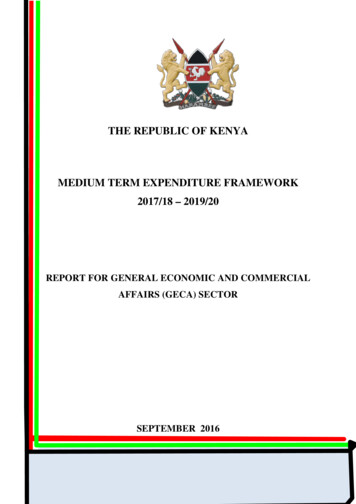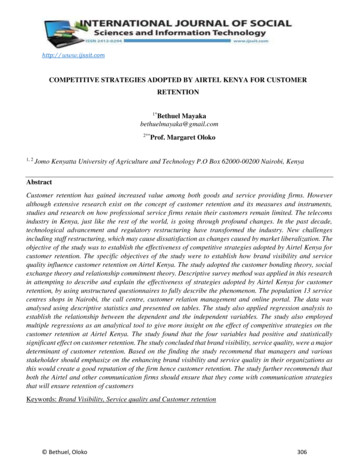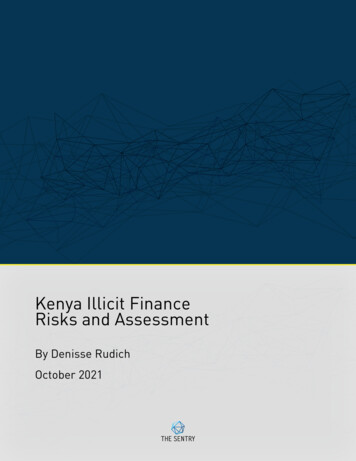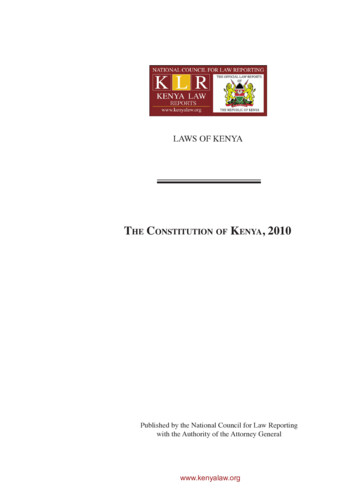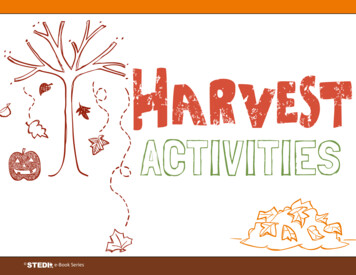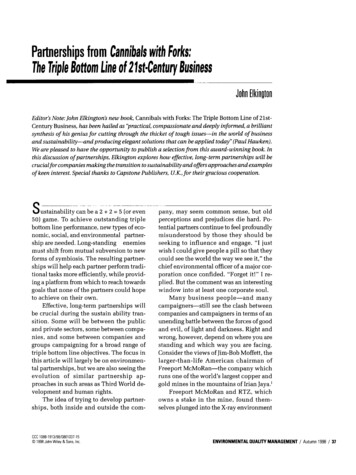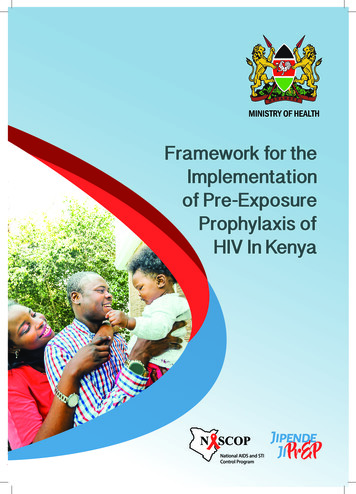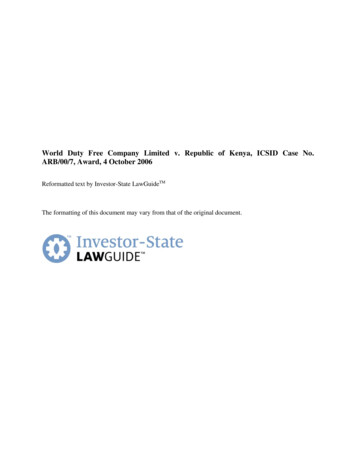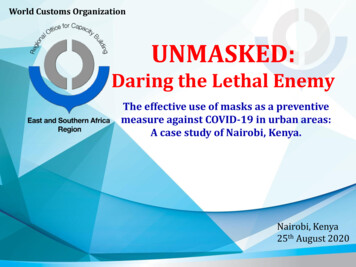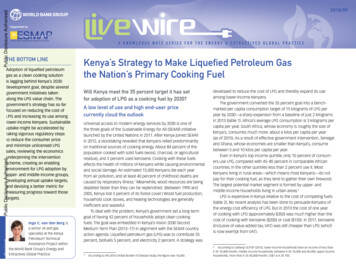
Transcription
Public Disclosure Authorized2018/89Supported byA AK NKONWO LWELDEGDEG EN ONTOET ES ESREI RE ISE SF OFRO RT HTEH E NEENREGRYG YP R&A CE TX ITCREA C T I V E S G L O B A L P R A C T I C ETHE BOTTOM LINElosure AuthorizedPublic Disclosure AuthorizedPublic Disclosure AuthorizedAdoption of liquefied petroleumgas as a clean cooking solutionis lagging behind Kenya’s 2030development goal, despite severalgovernment initiatives takenalong the LPG value chain. Thegovernment’s strategy has so farfocused on reducing the cost ofLPG and increasing its use amonglower-income Kenyans. Sustainableuptake might be accelerated bytaking vigorous regulatory stepsto reduce the consumer priceand minimize unlicensed LPGsales, reviewing the economicsunderpinning the interventionscheme, creating an enablingenvironment for LPG adoption byupper- and middle-income groups,developing annual uptake targets,and devising a better metric formeasuring progress toward thosetargets.Inge C. van den Berg isa senior oil and gasspecialist at the KenyaPetroleum TechnicalAssistance Project withinthe World Bank Group’s Energy andExtractives Global Practice.Kenya’s Strategy to Make Liquefied Petroleum Gasthe Nation’s Primary Cooking FuelWill Kenya meet the 35 percent target it has setfor adoption of LPG as a cooking fuel by 2030?A low level of use and high end-user pricecurrently cloud the outlookUniversal access to modern energy services by 2030 is one ofthe three goals of the Sustainable Energy for All (SE4All) initiativelaunched by the United Nations in 2011. After Kenya joined SE4Allin 2012, a stocktaking revealed that Kenyans relied predominantlyon traditional sources of cooking energy. About 84 percent of thepopulation cooked with solid fuels (wood, charcoal, or agriculturalresidue), and 5 percent used kerosene. Cooking with these fuelsaffects the health of millions of Kenyans while causing environmentaland social damage. An estimated 15,000 Kenyans die each yearfrom air pollution, and at least 40 percent of childhood deaths arecaused by respiratory illness.1 Meanwhile, wood resources are beingdepleted faster than they can be replenished. (Between 1990 and2005, Kenya lost 5 percent of its forest cover.) Wood fuel production,household cook stoves, and heating technologies are generallyinefficient and wasteful.To deal with the problem, Kenya’s government set a long-termgoal of having 42 percent of households adopt clean cookingfuels. The goal was embedded in Kenya’s Vision 2030 SecondMedium-Term Plan (2013–17) in alignment with the SE4All countryaction agenda. Liquefied petroleum gas (LPG) was to contribute 35percent, biofuels 5 percent, and electricity 2 percent. A strategy was1According to the 2016 Global Burden of Disease study, the figure was 16,600.developed to reduce the cost of LPG and thereby expand its useamong lower-income Kenyans.The government converted the 35 percent goal into a benchmarked per capita consumption target of 15 kilograms of LPG peryear by 2030—a sharp expansion from a baseline of just 2 kilogramsin 2013 (table 1). Africa’s average LPG consumption is 3 kilograms percapita per year. South Africa, whose economy is roughly the size ofKenya’s, consumes much more: about 6 kilos per capita per year(as of 2015). As a result of effective government intervention, Senegaland Ghana, whose economies are smaller than Kenya’s, consumebetween 5 and 10 kilos per capita per year.Even in Kenya’s top income quintile, only 10 percent of consumers use LPG, compared with 45–85 percent in comparable Africancountries. In the other quintiles less than 2 percent use it. MostKenyans living in rural areas—which means most Kenyans—do notpay for their cooking fuel, as they tend to gather their own firewood.The largest potential market segment is formed by upper- andmiddle-income households living in urban areas.2LPG is expensive in Kenya relative to the cost of competing fuels(table 2). No recent analysis has been done to persuade Kenyans ofthe energy cost efficiency of LPG. But in 2013 the cost of one yearof cooking with LPG (approximately 350) was much higher than thecost of cooking with kerosene ( 200) or coal ( 150). In 2017, kerosene(inclusive of value-added tax, VAT) was still cheaper than LPG (whichis now exempt from VAT).2According to Dalberg–GLPGP (2013), lower-income households have an income of less thanK Sh 10,000/month; middle-income households, between K Sh 10,000 and 40,000; upper-incomehouseholds, more than K Sh 40,000/month. US 1 K Sh 100.
2K e n y a ’ s S t r at e g y t o M ak e L i q u e f i e d P e t r o l e u m G as t h e Nat i o n ’ s P r i ma r y C o o k i n g F u e lTable 1. Actual and projected LPG consumption, 2013–30ActualLPG is expensive ams per capita2 2.1 2.8—————15Thousands of metric tons(including industry)6014917464 (est.)—— 1,100——Kenya relative to thePercentage of households9———1419—2635cost of competing fuels.Percentage of population5— 7——————No recent analysis hasSource: SE4All Kenya Action Agenda, Kenya National Bureau of Statistics, World Bank/WHO, PDC, Dalberg–GLPGP.been done to persuade— data not available. (The Kenya National Bureau of Statistics has not released 2018 consumption data.)Kenyans of the energy costefficiency of LPG. In 2017,kerosene (even with VAT)was still cheaper than LPG(now exempt from VAT).Table 2. 2017 retail prices of various cooking fuelsMonthly averageFuelPriceFirewoodFree (if collected)Charcoal K Sh 81 for a 4 kg tin (K Sh 20/kg)Kerosene K Sh 67/literLPG K Sh 160/kg (K Sh 82/liter )Source: Kenya National Bureau of Statistics.Table 3. Cost breakdown of LPG price, 2013US /tonShare of total price(%)1,46661.9Global reference price80834.1Shipping cost38016.1Cost itemLanded supply costStorage27811.7Bulk : Dalberg–GLPGP (2013).Note: Shares do not add to 100 percent because of rounding.:Several factors contribute to the high consumer price. Apartfrom fluctuations in the international import price, the landed supplycost is persistently high owing to the absence of an open tendersystem for bulk storage of LPG, and the margins retained by dealers,distributors, and retailers are unusually high (table 3). To this must beadded the substantial costs consumers pay for their cylinders, thestove, and accessories needed to use the gas.The top five of Kenya’s 44 licensed LPG dealers account for about80 percent of the market. Cylinders are available in 1, 3, 6, 13 kilogram sizes. Seventy percent of current demand is for the 6 kilogramsize; 20 percent for the 13 kilogram size. Small, inexpensive burnersfit on 6 kilogram cylinders, but the 13 kilogram size requires a moreexpensive stove. Because the larger cylinders are heavy and refillingpoints are few, consumers also face the expense of transportation tohave their cylinders refilled.Most retailers raised their prices by 15 percent in early 2017,following a global surge in gas prices (figure 1). Retail prices inthe first quarter of 2018 remained where they stood at the end of2017. The 2017 monthly average retail price was about 1.6/kg. A6 kilogram cylinder costs about 26. No recent breakdown of thecomponents of the retail gas price has been performed, but a 2013breakdown concluded that margins accounted for nearly 32 percentand landed supply costs for a disproportionally high 62 percent(table 3). A current cost breakdown would likely show similar results,though with a lower global reference price than in 2013.The consumer price of LPG has been deregulated since 1994.However, regulations that took effect in 2009 (based on the 2006Energy Act) permit the retail price to be regulated, and a new EnergyBill, not yet enacted, provides for wholesale price regulation.
3K e n y a ’ s S t r at e g y t o M ak e L i q u e f i e d P e t r o l e u m G as t h e Nat i o n ’ s P r i ma r y C o o k i n g F u e lFigure 1. Retail price of LPG by month, 2016 and 2017Figure 2. The LPG value chain in Kenya3.120162017Uptake is presentlymeasured as a percentageof consumers (individualsand households) usingK Sh thousands per 13 kg2.9practice known as fuelstacking. Therefore, themeasure tells us little aboutreductions in the use oftraditional cooking fuels.retailConsumer capacity2.11.91.5use of multiple fuels, arefill/wholesaleSource: Dalberg–GLPGP (2013), with author’s modifications.2.3neither the intensity norfor the simultaneousBulkstorage2.51.7use. Nor does it accountimport2.7LPG, but this metric reflectsthe sustainability of LPGGovernment ov.Dec.MonthSource: Kenya National Bureau of Statistics.Note: US 1 K Sh 100.Under the principal decree of the LPG Exchange Pool regulation,resellers and dealers belonging to the pool must sell LPG in standardized cylinders fitted with uniform safety valves, which promote pricecompetition by enabling consumers to have their cylinders refilled atany retail station. Retailers are required to return cylinders not bearingtheir own brand to a central depot, where they can exchange themfor cylinders belonging to their own “fleet.” Each pool member isresponsible for maintaining its licensed cylinder fleet (as before 2009).How has the strategy fared?Multiple challenges persist along the relatively longand complex LPG value chain—including inconsistentmeasures to track uptake, a high consumer price,ineffective regulation, and low popular awareness ofLPG’s advantagesKenya’s LPG value chain is long and complex, extending from thegovernment as strategist and planner through importation, bulkstorage, wholesaling, and retailing before reaching the consumer(figure 2). Consumer receptivity hinges, of course, on their awarenessof LPG’s advantages and willingness to alter longstanding cookingand heating practices, but also (and critically) on their ability to affordboth the fuel and the stoves that burn it.Uptake is presently measured as a percentage of consumers(individuals and households) using LPG, but this metric reflectsneither the intensity nor the sustainability of LPG use. Nor does itaccount for the simultaneous use of multiple fuels, a practice knownas fuel stacking. Therefore, the measure tells us little about reductions in the use of traditional cooking fuels. Because data on quantities of LPG consumed (reported in table 1) include industrial use andare affected by irregularities in the refilling of cylinders, the apparentupward trend in consumption until 2017 is not reliable enough tojustify a conclusion of sustainable adoption of LPG as cooking fuel.Indeed, the 2017 price and sales figures (reported in tables 1 and 2)suggest a contrary conclusion.The price remains high in part because, as noted, Kenya has noproperly functioning open tender system for bulk storage of LPG(as it does for other petroleum products). Bulk storage for importedvolumes is limited, and handling in port is dominated by a singlefirm. Compounded by inadequate inland storage, the insufficientbulk storage capacity has resulted in the importation of shipmentsof uneconomic size. Together, these factors explain the high landedsupply costs that raise prices to Kenyan consumers.Uptake is further undercut by the weak enforcement ability ofthe relevant regulatory authority. Its enforcement power is weakbecause the legal status of the exchange pool is not clearly definedin the 2006 Energy Act and because of the absence of any systemfor tracking cylinders bearing various dealer brands, which makesit impossible to monitor compliance with the cylinder-exchangerequirements upon which effective competition, as well as safety,depend. The threshold for becoming a member of the pool is just
4K e n y a ’ s S t r at e g y t o M ak e L i q u e f i e d P e t r o l e u m G as t h e Nat i o n ’ s P r i ma r y C o o k i n g F u e lAn audit is needed tounderstand the costcomponents behind theLPG retail price and tosupport the introductionof a regulatory pricingmodel. Once that isdone, publication ofindicative LPG pricing(and reasonable margins)will encourage pricecompetition among brandsand raise consumerawareness. If theimplementation of an opentender system does notlower retail prices, pricecaps could be considered.Revisions to the LPGExchange Pool Regulationshould introduce acylinder tracking systemand raise the thresholdfor participation in theexchange pool to reduceirregularities in refilling.5,000 cylinders. Given the low cylinder threshold for pool participation, combined with the relatively long household turnaround time,the current regulation has resulted in some illegal cross-filling ofcylinders not bearing the brand of the firm that initially filled them.The poorly regulated cylinder exchange system (with certainretailers slow to follow through with required exchanges) undermines the surveillance of cylinder maintenance and threatens theviability of dealers with small fleets of cylinders. Irregularities inrefilling and poor cylinder maintenance have led to fatal accidents.Because of the foregoing problems, LPG is perceived by manyKenyans as less safe than other fuels and more suitable for thewealthy. The data available to address safety-related perceptionsare limited; meanwhile, LPG’s high price relative to that of traditionalfuels reinforces some of the negative price perceptions. The bettereducated (particularly women) are more favorably disposed towardLPG, but Kenya still lacks a critical mass of well-educated people.What is Kenya’s government doing to meetthese challenges?Projects are under way to improve the government’scapacity to revise the legislative frameworksurrounding LPG, to lower the price of the fuel, tomanage the LPG subsidy campaign, and to remedydeficiencies in the supply, distribution, and storageinfrastructureIn early 2015, the Ministry of Energy and Petroleum embarked on asix-year World Bank–funded technical assistance project (dubbedKEPTAP) to strengthen its capacity to manage the petroleumsector. Several reforms and capacity-building actions, including thedevelopment of an LPG distribution model and public awarenessplan, are being pursued. An agency working group was establishedin 2016 and a review of regulations affecting LPG was scheduled for2017. The 2017 electoral campaign delayed enactment of the newEnergy Act and revision of the related regulations (including the LPGExchange Pool decree) until 2018.Kenya’s entire supply of liquefied petroleum gas (LPG) has beenimported since production at the Mombasa refinery, which had methalf of domestic demand, was halted in 2013 so that the refinerycould be renovated. Eight percent of Kenya’s LPG is imported overland from neighboring Tanzania; the remaining 92 percent comes inthrough two terminals at the port of Mombasa, most of it through theprivately owned terminal.The private terminal has a bulk storage capacity of about 26,000metric tons and a temporary floating facility of 14,000 metric tons.The closed Mombasa refinery and the publicly owned terminal areable to store just 3,000 metric tons. So far the government has notopted to create a national buffer stock, though doing so wouldenable it to stabilize prices—for example, in the case of unforeseensupply shortfalls.Additional storage facilities (port and inland), a new jetty, anda supply pipeline are scheduled to be completed by 2019. Lookingfurther out, the import storage capacity is slated for further expansion. In the meantime, overland Tanzanian imports equivalent toabout 40,000 metric tons per year were suspended in mid-2017 tominimize illegal cross-border trade.The VAT on LPG was cut from 16 percent to zero in mid-2016, buta 16 percent VAT and 25 percent import duty still apply to cylindersand accessories (gauges, valves, hoses). High-efficiency cook stovesare subject to a lower VAT than less-efficient models. To makekerosene less cost-competitive, a further increase from the current15 percent VAT is being considered.Since 2016, pilot projects have tested smaller sizes bottles, nonmetal cylinder fabrics, and the use of mobile phone tokens for refillsand down payments. Evaluations of these pilots are ongoing.A government program—the Mwananchi gas project—tosubsidize the cost of cylinders was launched in July 2017 (figure 3).Under the multi-year program, between 5 and 15 million cylinders(1.2 million cylinders per annum), each fitted with a cooking stove,are to be provided to low-income families.3 The subsidy covers 60percent of the price for the package. Implementation of the programhas been entrusted to the National Oil Corporation of Kenya, but, in3The current national fleet of cylinders numbers no more than four million. As many asfifteen million new cylinders may be needed to meet the 35 percent adoption target.
5K e n y a ’ s S t r at e g y t o M ak e L i q u e f i e d P e t r o l e u m G as t h e Nat i o n ’ s P r i ma r y C o o k i n g F u e lFigure 3. An advertisement for Kenya’s new subsidizedLPG programUntil the retail price of LPGhas been brought downsubstantially, it is unlikelythat lower-income Kenyanswill sustainably switch toSource: National Oil, as/.LPG even after receivinga subsidized cylinder. Fornow, therefore, upper- andmiddle-income consumersare the primary groups totarget.view of the company’s small share of the LPG market (5 percent),its capacity will have to be expanded to execute the program. Thecylinder subsidy project is expected to be financed from whatremains of the former kerosene subsidy fund.What could the government do differently toaccelerate sustainable LPG uptake?More-stringent regulation, a long-term economicview, annual targets using a single uptake metric,and expanding the market among higher-incomegroups are the places to startKenya’s government can put its lagging LPG adoption program backon track to achieve the country’s clean cooking goal by 2030. To doso, it should consider some or all of the following recommendations.Take strong regulatory steps to bring down the retailprice and minimize unlicensed LPG sales. An audit is needed tounderstand the cost components behind the LPG retail price and tosupport the introduction of a regulatory pricing model. Once that isdone, publication of indicative LPG pricing (and reasonable margins)will encourage price competition among brands and raise consumerawareness. When the common import storage facility is completed,an open tender system will introduce competitiveness and may bringdown the landed supply cost. If reduction in the landed cost doesnot decrease the retail price, retail price caps could be considered.Revisions to the Exchange Pool Regulation should introduce acylinder tracking system and raise the threshold for participation inthe exchange pool to reduce irregularities in refilling.Review the economics underpinning the interventionscheme. The commercial viability of the infrastructure projects andthe cylinder subsidy program, as well as the potential of the fiscalrevenue stream along the value chain, need to be clarified. Variousactions and conditions—notably the rollout of an open tendersystem for imports upon completion of the infrastructure projectsand the distribution of 15 million subsidized cylinders—should besynchronized to optimize revenue and effectiveness.Promote demand for LPG among upper- and middle-income consumers. Until the retail price of LPG has been broughtdown substantially, it is unlikely that lower-income Kenyans willsustainably switch to LPG even after receiving a subsidized cylinder.In the meantime, the 2015–16 National Household Budget Survey(released in March 2018) and an energy cost efficiency analysis of allcooking fuels should drive the methodology to make LPG attractiveto as many consumers as possible.Develop annual targets and a clear metric to track progress in LPG uptake and to make possible timely changes tothe implementation program. The deepening of LPG use shouldbe tracked in terms of consumption per capita. The 2019 censuswill verify actual population growth over the level assumed in 2013.On that basis, a target should be developed for yearly total demandto 2030. Integrating the per capita rates thus set with the country’snational plans, beginning with the Third Medium-Term Plan (2018–22),will foster performance tracking and timely adaption of executionplans.
6K e n y a ’ s S t r at e g y t o M ak e L i q u e f i e d P e t r o l e u m G as t h e Nat i o n ’ s P r i ma r y C o o k i n g F u e lMAKE FURTHERCONNECTIONSLive Wire 2015/46. “ResultsBased Financing to PromoteClean Stoves: Initial Lessonsfrom Pilots in China andIndonesia,” by Yabei Zhang andNorma Adams.Live Wire 2016/62. “TowardUniversal Access to CleanCooking and Heating: Lessonsfrom the East Asia and PacificClean Stove Initiative,” by YabeiZhang and Norma Adams.Live Wire 2016/63. “The LaoCook Stoves Experience:Redefining Health in the LaoPopulation through the EnergySector Lens,” by Rutu Dave andRema N. Balasundaram.Live Wire 2016/64. “ContextualDesign and Promotion of CleanBiomass Stoves: The Case ofthe Indonesia Clean StoveInitiative,” by Laurent Durix,Helene Carlsson Rex, andVeronica Mendizabal.Live Wire 2017/74, “Increasingthe Use of Liquefied PetroleumGas in Cooking in DevelopingCountries,” by Richenda VanLeeuwen, Alex Evans, andBesnik Hyseni.Find these and the entire Live Wirearchive at 7135.SourcesDalberg, Global LPG Partnership, Global Alliance for CleanCookstoves. 2013. “GLPGP–Kenya Market Assessment.” August28. itute for Health Metrics and Evaluation. 2016. Global Burdenof Disease study 2016. Seattle. http://ghdx.healthdata.org/gbd-2016-code.Kenya National Bureau of Statistics, 2013–2017 data.For example, ndicator-december-2017/.Kojima, M. 2011. “The Role of Liquefied Petroleum Gas in ReducingPoverty.” Extractive Industries for Development Series 25, WorldBank, Washington, DC. December. es/LPGReportWeb-Masami.pdf.———. 2012. “Promoting Household Adoption of Bottled Gas.” WorldBank, Washington, DC.Ministry of Energy and Petroleum. 2016. “SE4All, Kenya ActionAgenda” ntry-data/kenya/.National Oil Corporation of Kenya. 2015. “Overview of Oil and GasSector in Kenya,” CEO presentation, October. ortunities.pdf.Petroleum Development Consultants. 2005. “Liquefied Petroleum GasDemand Study in Kenya and the East Africa Region.” London.———. 2013. “Feasibility Study for Inland Bulk Liquefied PetroleumGas Storage and Bottling Facilities in Kenya for KPC.” London.Republic of Kenya. 2013. “Kenya Vision 2030—Second Medium-TermPlan (2013–2017).” http://vision2030.go.ke/2013-2017/.Van Leeuwen, R., M. Evans, and B. Hyseni. “Increasing the Use ofLiquefied Petroleum Gas in Cooking in Developing Countries.”Live Wire 2017/74, World Bank, Washington, DC. 6569.World Bank. 2014a. “Kenya—Petroleum Technical AssistanceProject.” Project Appraisal Document 831, World Bank,Washington, DC. June 30. http://projects.worldbank.org/P145234?lang en.———. 2014b. Clean and Improved Cooking in Sub-Saharan Africa.Second edition. Report no. 98664. Energy Sector ManagementAssistance Program and Africa Renewable Energy AccessProgram, World Bank. November 2014. 2521.World Bank and Institute for Health Metrics and Evaluation. 2016.The Cost of Air Pollution: Strengthening the Economic Case forAction. Washington, DC: World Bank. 5013.World LPG Association. 2015. “Accelerating the LPG Transition.Neuilly-sur-Seine, France. -lpg-transition-2015/.AcknowledgmentsI would like to express my gratitude to the task team leaders of the KenyaPetroleum Technical Assistance Project, Alexander Huurdeman and DavidReinstein, who provided me with their valuable support. Furthermore, I amthankful to Masami Kojima and Richard Hosier, senior energy specialists atthe World Bank, who offered their expertise.DisclaimerThis work is a product of the staff or a consultant of the WorldBank with external contributions. The findings, interpretations, andconclusions expressed in this work do not necessarily reflect theviews of the World Bank, its Board of Executive Directors, or thegovernments they represent. The World Bank does not guaranteethe accuracy of the data included in this work. The boundaries,colors, denominations, and other information shown on any map inthis work do not imply any judgment on the part of the World Bankconcerning the legal status of any territory or the endorsement oracceptance of such boundaries.
Get Connected to Live WireThe Live Wire series of online knowledge notes, an initiative of the World Bank Group’sEnergy and Extractives Global Practice, offers rich insights from project and analytical workdone by the World Bank Group.“Live Wire is designedfor practitioners, policymakers, and plannersinside and outside theWorld Bank Group.It is a resource toshare with clients,colleagues, andcounterparts.”Every day, Bank Group experts apply their knowledge and expertise to solve practical problems inclient countries. Live Wire captures the rich insights gained in the field, allowing authors to sharetheir findings with other practitioners, policy makers, and planners.Shouldn’t you be connected to Live Wire?Since 2014, the 80 briefs in the series have dealt with vital topics such as energy demand andsupply; renewable energy; energy efficiency; energy policy; economic growth; environmentalprotection; climate change mitigation; power systems; rural and urban development; access toenergy; infrastructure economics; private sector participation; access to finance; and regulation. Topic briefs offer technical knowledge on key energy issues. Case studies highlight lessons from experience in implementation, often with insights fromprivate sector engagement. Briefs on global trends provide analytical overviews of key energy data and developments. Bank views portray the Bank Group’s energy and extractives sector activities.The format is accessible, rigorous, and concise enough to be easily shared. The 4–12 pagesof each brief make ample use of graphics. Briefs are peer-reviewed by seasoned practitionerswithin the World Bank Group and professionally edited and produced. While their main channel ofdissemination is online, Live Wires are available in print-ready files for specific client needs.Please visit the World Bank Group’s Open Knowledge Repository tobrowse the Live Wire collection and download the issues importantto you: www.worldbank.org/energy/livewireLive Wire briefs aredesigned for easy readingon the screen and fordownloading and self-printingin color or black and white.For World Bank Groupemployees: Professionalprinting can be done on acustomized basis for meetingsand events by contactingGSDPM Customer ServiceCenter at (202) 458-7479, orsending a written request tocgsdpm@worldbank.org.
An invitation to World Bank Group staffContribute toDo you have something to say?Say it in Live Wire!Those working on the front lines of energy and extractives development in emerging economieshave a wealth of technical knowledge and case experience to share with their colleagues but maynot have the time to write for publication.Live Wire offers prospective authors a support system to make it easier to share their knowledge: Staff from the Energy and Extractives Global Practice are available to assist operations staff indrafting Live Wire stories. User-friendly guidelines help authors mold their contribution to the expectations of the Live Wireaudience. A professional series editor ensures that the writing is punchy and accessible. A professional graphic designer assures that the final product looks great—a feather in your cap!Since 2014 the Energy and Extractives Global Practice has produced 80Live Wire briefs under the bylines of 240 staff authors. Live Wire briefshave been downloaded thousands of times from the WorldBank’s Open Knowledge Repositoryand circulated in printed form forYour Name Herecountless meetings and events.Live Wire aims to raise the profileof operational staff with practicalknowledge to share—wherever theyare based.Become a Live Wiretoauthor and contribute,your practice and careerdgooingdelwhile mo“knowledge citizenship”by sharing your insightsers.and experience with othIf you can’t spare thetime to contribute toLive Wire but have an ideafor a topic or case we shouldcover, let us know!We welcome your ideas throughany of the following channels:Via the Communities of Practicein which you are activeBy participating in the Energyand Extractives Global Practice’sannual Live Wire series reviewmeetingBy communicating directlywith the Live Wire team(contact Jonathan Davidar,jdavidar@worldbankgroup.org)
2 KenyA’S STrATeGy To MAKe Liquefied PeTroLeuM GAS The nATion’S PriMAry CooKinG fueL LPG is expensive in Kenya relative to the cost of competing fuels. No recent anal

